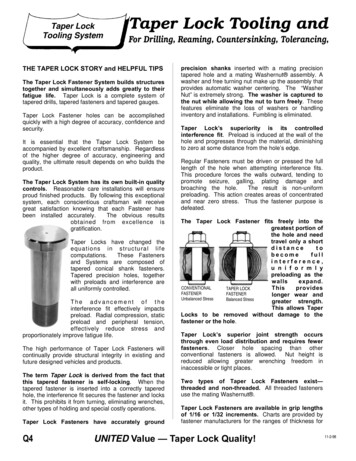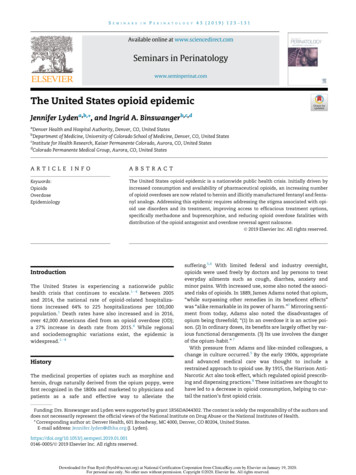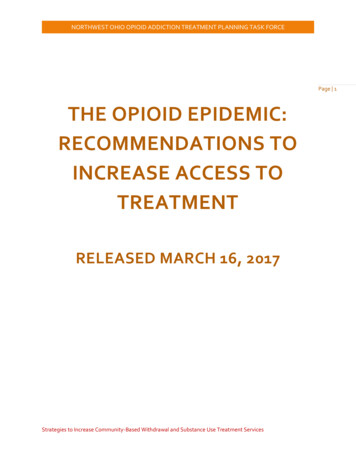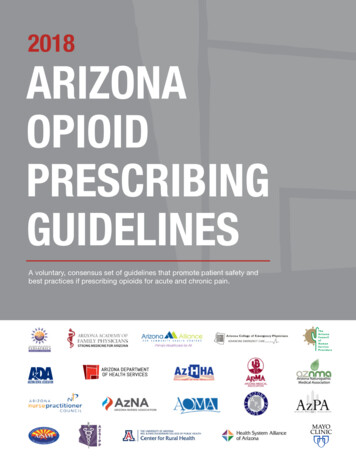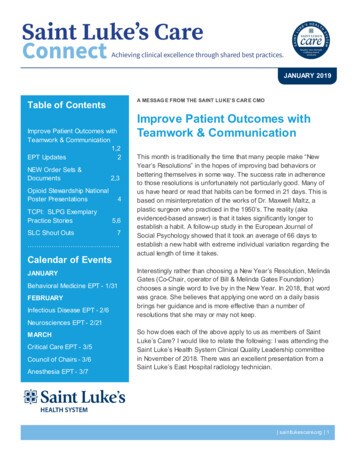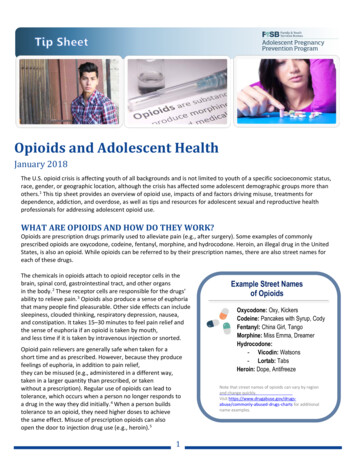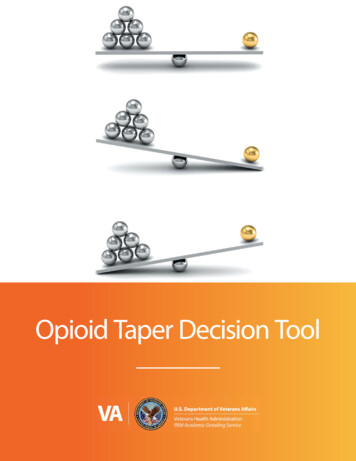
Transcription
Opioid Taper Decision Tool
Pain ManagementOpioid Taper Decision ToolA VA Clinician's GuideVA PBM Academic Detailing ServiceReal Provider ResourcesReal Patient ResultsYour Partner in Enhancing Veteran Health OutcomesVA PBM Academic Detailing Service Email Group:PharmacyAcademicDetailingProgram@va.govVA PBM Academic Detailing Service SharePoint s/Home.aspxVA PBM Academic Detailing Public gservicehome.asp
The Opioid Taper Decision Tool is designed to assist PrimaryCare providers in determining if an opioid taper is necessaryfor a specific patient, in performing the taper, and inproviding follow-up and support during the taper.Opioid prescribing recommendations: summary of 2016 CDC Guidelines1Determining when toinitiate or continueopioids for chronic pain Opioids are not first-lineor routine therapy Establish treatment goalsbefore starting opioidtherapy and a plan iftherapy is discontinued Only continue opioidif there is clinicallymeaningful improvementin pain and function Discuss risks, benefitsand responsibilities formanaging therapy beforestarting and duringtreatmentOpioid selection, dosage,duration, follow-up anddiscontinuation Use immediate-release(IR) opioids when startingtherapy Prescribe the lowesteffective dose When using opioids foracute pain, provide nomore than needed for thecondition Follow up and reviewbenefits and risks beforestarting and during therapy If benefits do not outweighharms, consider taperingopioids to lower doses ortaper and discontinuePrescription drug monitoring programUrine drug testing***Some VA facilities may require more frequent testing****Medication-assisted treatment†Opioid use disorder***2Assessing risk andaddressing harms ofopioid use Offer risk mitigationstrategies, includingnaloxone for patients atrisk for overdose Review PDMP* data atleast every 3 months andperform UDT** at leastannually*** Avoid prescribing opioidand benzodiazepinesconcurrently whenpossible Clinicians should offer orarrange MAT**** for patientswith OUD†
Possible reasons to re-evaluate the risks and benefits of continuingopioid therapy:Opioids are associated with many risks and it may be determined that they are not indicated for painmanagement for a particular Veteran.1 No pain reduction, noimprovement in functionor patient requests todiscontinue therapy Severe unmanageableadverse effects (e.g.,drowsiness, constipation,cognitive impairment) Dosage indicates high riskof adverse events (e.g.,doses of 90 MEDD* andhigher) Non-adherence to thetreatment plan or unsafebehaviors** (e.g., early refills,lost/stolen prescription,buying or borrowingopioids, failure to obtain oraberrant UDT***) Concerns related to anincreased risk of SUD****(e.g., behaviors, age 30,family history, personalhistory of SUD†) Overdose event involvingopioids Medical comorbidities thatcan increase risk (e.g., lungdisease, sleep apnea, liverdisease, renal disease, fallrisk, advanced age) Concomitant use ofmedications that increaserisk (e.g., benzodiazepines) Mental healthcomorbidities that canworsen with opioid therapy(e.g., PTSD, depression,anxiety)Consider Tapering OpioidPrior to any changes in therapy, discuss the risks of continued use, along withpossible benefits, with the Veteran. Establish a plan to consider dose reduction,consultation with specialists, or consider alternative pain management strategies.Morphine equivalent daily doseConsider assessment for opioid use disorder (OUD)***Urine drug test****Substance use disorder†Personal history of SUD includes alcohol use disorder (AUD), opioid use disorder (OUD), and/or a use disorder involving other substances***3
When considering an opioid taper, monitor for conditions that maywarrant evaluation and arrange primary care and/or emergencydepartment follow-up when indicated:2Disorders that may need urgent evaluationIf a patient is taking more than their prescribed dosage of opioids or showing signs of aberrantbehavior, before deciding to change therapy, look for the following “red flags”:Progressive numbness or weaknessProgressive changes in bowel or bladderfunctionUnexplained weight lossHistory of internal malignancy that has notbeen re-stagedSigns of/risk factors for infection(fever, recent skin or urinary infection,immunosuppression, IV drug use)Ensure screening and treatment is offered for conditions thatcan complicate pain management before initiating opioid taper:1, 3, 4Mental health disorders (e.g., PTSD, anxiety disorders, depressive disorders) If suicidal, then activate suicide prevention plan. If high suicide risk or actively suicidal, consult with mental health provider before beginning taper.Opioid use disorder (OUD) and other substance use disorders (SUD) The lifetime prevalence for OUD among patients receiving long-term opioid therapy is estimatedto be about 41%: approximately 28% for mild symptoms, 10% for moderate symptoms and 3.5%for severe symptoms of OUD. Patients with chronic pain who develop OUD from opioid analgesic therapy need to have BOTHpain and OUD addressed. Either tapering the opioid analgesic or continuing to prescribe theopioid without providing OUD treatment may increase the risk of overdose and other adverseevents. Refer to DSM 5 criteria for OUD.3 Use a shared decision-making approach to discuss options for OUD treatment:– First-line: Medication Assisted Therapy (MAT)— PREFERRED: Opioid Agonist Therapy (OAT)—buprenorphine/naloxone (Suboxone )or methadone maintenance*— ALTERNATIVE: Extended Release (ER) Injectable Naltrexone (Vivitrol )– MAT can be provided in a variety of treatment settings including: residential SUD treatment,intensive outpatient SUD treatment, regular SUD specialty care clinic, primary care or generalmental health clinic, or federally regulated opioid treatment program.Methadone must be provided through a federally regulated opioid treatment program for OUD therapy.*4
“Moral injury” (inner conflict) An act of transgression that leads to serious inner conflict typically brought on by:– Betrayal, disproportionate violence, incidents involving civilians, within-rank violence Treatment via psychologists or chaplains is availableCentral sensitization (e.g., fibromyalgia, chronic headaches, and likely many other types of complexchronic pain)Medical complications (e.g., lung disease, hepatic disease, renal disease, or fall risk)Sleep disorders including sleep apneaWhen a decision is made to taper, special attention must be given to ensure that the Veteran doesnot feel abandoned. Prior to any changes being made in opioid prescribing, a discussion shouldoccur between the Veteran, family members/caregivers, and the provider either during a face-toface appointment or on the telephone.Using all the following strategies will help in the transition:DiscussionAsk about goals Listen to the Veteran’sstory Draw out their goals for life(not just being pain-free) Let the Veteran knowthat you believe thattheir pain is real Have the Veteran fill out thePersonal Health Inventory(PHI)* Include familymembers or othersupporters in thediscussion Ask how we can supportthem during the taperEducate the Veteran Use Bio-Psycho-Social Model– e.g., PHI’s “Whole Health”approach* Offer Veterans pain education groups[especially Cognitive BehavioralTherapy (CBT) or Acceptance andCommitment Therapy (ACT) for Pain,if available] Offer physical therapy andComplementary and IntegrativeHealth (CIH) interventions such as:– acupuncture, meditation, yoga Acknowledge theVeteran’s fearsabout tapering[use MotivationalInterviewing (MI)techniques] Slowly tapering opioids to reduceopioid risks while not “cutting off” theVeteran Offer non-opioid pain medicationswhen appropriate** Commit to working with the Veteranon other options for improvedfunction and some decrease in painPHI’s Whole Health Approach: t-whole-health.aspPain Management Opioid Safety VA Education Guide 2014, pages 5-6: n%20Management.aspx***5
Considerations when formulating an opioid taper plan: Determine if the initial goal is a dose reduction or complete discontinuation. If initial goal isdetermined to be a dose reduction, subsequent regular reassessment may indicate that completediscontinuation is more suitable. Several factors go into the speed of taper selected:– Slower, more gradual tapers are often the most tolerable and can be completed over severalmonths to years based on the opioid dose.– The longer the duration of previous opioid therapy, the longer the taper may take.Most commonly, tapering will involve dosereduction of 5% to 20% every 4 weeks. More rapid tapers may be required in certain instances like drug diversion, illegal activities, orsituations where the risks of continuing the opioid outweigh the risks of a rapid taper. Document the rationale for the opioid taper and the opioid taper schedule in the Veteran’smedical record. Provide opioid overdose education and prescribe naloxone to patients at increasedrisk of overdose. Strongly caution patients that it takes as little as a week to lose their tolerance andthat they are at risk of an overdose if they resume their original dose. Patients are at an increased risk of overdose during this process secondaryto reduced tolerance to opioids and the availability of opioids and heroin inthe community.6
Example Tapers for Opioids5-9Slowest Taper(over years)Slower Taper (overmonths or years)Faster Taper(over weeks)****Rapid Taper(over days)****Reduce by 2 to 10%every 4 to 8 weekswith pauses in taperas neededReduce by 5 to 20%every 4 weeks withpauses in taper asneededReduce by 10 to 20%every weekConsider for patientstaking high doses oflong-acting opioids formany yearsMOST COMMONTAPERReduce by 20 to 50%of first dose ifneeded, then reduceby 10 to 20% everydayEx: morphine SR 90 mgQ8h 270 MEDDEx: morphine SR 90 mgQ8h 270 MEDDEx: morphine SR 90 mgQ8h 270 MEDDEx: morphine SR 90 mgQ8h 270 MEDDMonth 1: 90 mg SRqam, 75 mg noon,90 mg qpm [5%reduction]*Month 2: 75 mg SRqam, 75 mg noon,90 mg qpmMonth 3: 75 mg SR(60 mg 15 mg) Q8hMonth 4: 75 mg SRqam, 60 mg noon,75 mg qpmMonth 5: 60 mg SRqam, 60 mg noon,75 mg qpmMonth 6: 60 mg SRQ8hMonth 7: 60 mg SRqam, 45 mg noon,60 mg qpmMonth 8: 45 mg SRqam, 45 mg noon,60 mg qpmMonth 9: 45 mg SRQ8h**Month 1:75 mg (60 mg 15mg)SR Q8h [16%reduction]Week 1:75 mg SR Q8h[16% reduction]Day 1:60 mg SR (15 mg x 4)Q8h [33% reduction]Week 2:60 mg SR (15 mg x 4)Q8hDay 2:45 mg SR (15 mg x 3)Q8hWeek 3:45 mg SR (15 mg x 3)Q8hDay 3:30 mg SR (15 mg x 2)Q8hWeek 4:30 mg SR (15 mg x 2)Q8hDay 4:15 mg SR Q8hMonth 2:60 mg SR Q8hMonth 3:45 mg SR Q8hMonth 4:30 mg SR Q8hMonth 5:15 mg SR Q8hWeek 5:15 mg SR Q8hMonth 6:15 mg SR Q12hWeek 6:15 mg SR Q12hMonth 7:15mg SR QHS,then stop***Days 5-7:15 mg SR Q12hDays 8-11:15 mg SR QHS, thenstop***Week 7:15 mg SR QHS x 7days, then stop***Continue the taper based on Veteran response. Pauses in the taper may allow the patient time to acquire new skills for management of pain and emotional distresswhile allowing for neurobiological equilibration.**Continue following this rate of taper until off the morphine or the desired dose of opioid is reached.***May consider morphine IR 15 mg ½ tablet (7.5 mg) twice daily.****Rapid tapers can cause withdrawal effects and patients should be treated with adjunctive medications to minimize these effects; may need to consider admittingthe patient for inpatient care. If patients are prescribed both long-acting and short-acting opioids, the decision about which formulation to be tapered first should beindividualized based on medical history, mental health diagnoses, and patient preference. Data shows that overdose risk is greater with long-acting preparations.*7
Communicate the opioid taper plan to the VeteranExample: Veteran is currently taking morphine SR 60 mg, 1 tablet every 8 hours. Goal is to reduce doseof morphine to SR 30 mg every 8 hours using a slow taper. Dose will be reduced by 15 mg every 10 days.Using morphine SR 15 mg tablets, follow the schedule below:MorningAfternoonEveningDays 1 to 104 tablets 60 mg3 tablets 45 mg4 tablets 60 mgDays 11 to 203 tablets 45 mg3 tablets 45 mg4 tablets 60 mgDays 21 to 303 tablets 45 mg3 tablets 45 mg3 tablets 45 mgScenario 1: Veteran is tolerating the taper8
Scenario 2: Veteran is resisting further reduction*If the Veteran is resisting further dose reductions, explore the reason for the reluctance: medical (increased pain), mental health (worsening depression, anxiety,etc.), and substance use disorder (SUD)/opioid use disorder (OUD). Refer to OUD Provider Education Guide on VA PBM Academic Detailing SharePoint for moreinformation. .aspx**If possible, the Veteran should be actively involved in skills training and/or have a comprehensive pain care plan.Follow up with the Veteran during the taper:Follow UpSlowest Taper(over years)Slower Taper(over months)Faster Taper(over weeks)Rapid Taper(over days)When1 to 4 weeksafter startingtaper thenmonthly beforeeach reduction1 to 4 weeksafter startingtaper thenmonthly beforeeach reductionWeekly beforeeach dosereductionDaily before eachdose reduction orif available offerinpatient admissionWhoHowWhatPACT Team*Clinic and/ortelephone**Clinic and/ortelephone**Clinic and/ortelephone**Hospital, clinic ortelephone**Patient function,*** pain intensity, sleep, physical activity, personal goals, and stress levelFollow-up for tapering is recommended to be a team function with various team members taking on roles in which they have demonstrated specific competencies.Mental health practitioners may need to be included in the follow-up plan.**Providers will need to determine whether a telephone or in-clinic appointment is appropriate based on the risk category of the Veteran. A Veteran with high risk dueto a medical condition may have decompensation during the taper and may require a clinic visit over telephone follow-up. If there are issues with the Veteran obtainingoutside prescriptions or they are displaying other aberrant behaviors during the taper, providing follow-up in a clinic visit may be more optimal than a telephone visit.***Quality of Life Scale for patients with pain: https://www.theacpa.org/uploads/documents/Quality of Life Scale.pdf*9
Manage withdrawal symptoms during the taper:10Short-term oral medications can be utilized to assist with managing the withdrawalsymptoms, especially when prescribing fast tapers. Do not treat withdrawal symptoms withan opioid or benzodiazepine.Early Symptoms(hours to days)Late Symptoms(days to weeks)Prolonged Symptoms(weeks to months) Anxiety/restlessness Runny nose, tearing eyes Irritability, fatigue Rapid short respirations Rapid breathing, yawning Bradycardia Runny nose, tearing eyes,sweating Tremor, diffuse musclespasms/aches Decreased body temperature Insomnia Piloerection Dilated reactive pupils Nausea, vomiting, anddiarrhea Insomnia Abdominal pain Fever, chills Increased white blood cellsif sudden withdrawal10 Craving
Consider use of adjuvant medications during the taper to reducewithdrawal symptoms: 6-9, 11-19Short-term oral medications can be utilized to assist with managing the withdrawal symptoms,especially during fast tapers.IndicationTreatment OptionsAutonomic symptoms(sweating, tachycardia,myoclonus)First line Clonidine 0.1 to 0.2 mg oral every 6 to 8 hours; hold dose if blood pressure 90/60 mmHg (0.1 to 0.2 mg 2 to 4 times daily is commonly used in theoutpatient setting)– Recommend test dose (0.1 mg oral) with blood pressure check1 hour post dose; obtain daily blood pressure checks; increasing doserequires additional blood pressure checks– Re-evaluate in 3 to 7 days; taper to stop; average duration 15 daysAlternatives Baclofen 5 mg 3 times daily may increase to 40 mg total daily dose– Re-evaluate in 3 to 7 days; average duration 15 days– May continue after acute withdrawal to help decrease cravings– Should be tapered when it is discontinued Gabapentin start at 100 to 300 mg and titrate to 1800 to 2100 mg divided in2 to 3 daily doses*– Can help reduce withdrawal symptoms and help with pain, anxiety,and sleep Tizanidine 4 mg three times daily, can increase to 8 mg three times dailyAnxiety, dysphoria,lacrimation, rhinorrhea Hydroxyzine 25 to 50 mg three times a day as needed Diphenhydramine 25 mg every 6 hours as needed**Myalgias NSAIDs (e.g., naproxen 375 to 500 mg twice daily or ibuprofen 400 to 600mg four times daily)*** Acetaminophen 650 mg every 6 hours as needed Topical medications like menthol/methylsalicylate cream, lidocainecream/ointmentSleep disturbance Trazodone 25 to 300 mg orally at bedtimeNausea Prochlorperazine 5 to 10 mg every 4 hours as needed Promethazine 25 mg orally or rectally every 6 hours as needed Ondansetron 4 mg every 6 hours as neededAbdominal cramping Dicyclomine 20 mg every 6 to 8 hours as neededDiarrhea Loperamide 4 mg orally initially, then 2 mg with each loose stool, not toexceed 16 mg daily Bismuth subsalicylate 524 mg every 0.5 to 1 hour orally, not to exceed4192 mg/dayadjust dose if renal impairment; ** avoid in Veterans 65 years old; ***caution in patients with risk GI bleed, renal compromise, cardiac disease*11
Online Resources Available:Brainman & Understanding Pain (2-3 min): n-education-project-jpepVideos for Veterans to understand their own role in healing from the American Chronic Pain Association (ACPA): Four flat tires: http://www.theacpa.org/a-car-with-four-flat-tires Veterans in Pain: http://www.theacpa.org/video/veteransinpainVideos Instructing on Self-paced Exercise: Exercise Guidelines: http://www.youtube.com/watch?v gN-WwxfPIZoOther web-based Education for Back Pain, Neck Pain, and Headaches: on/Exercise/ExerciseVideo.aspx http://www.knowyourback.org/Documents/Cervical Exercise.pdfDeep Breathing Exercises: http://www.youtube.com/watch?v YdsipKCACac http://www.t2.health.mil/apps/breathe2relax (Phone app)Progressive Muscle Relaxation Techniques: t id 269532Opioid Overdose Education and Naloxone Distribution (OEND) Implementation SharePoint: D/default.aspxVA Dashboards That Can Identify High-Risk Veterans on Opioid Therapy: OTRR (VSSC Opioid Therapy Risk rtServer/Pages/ReportViewer.aspx?/PC/Almanac/PAIN ProviderWEB&rs:Command Render OSI (Opioid Safety Initiative) orts/Pages/Folder.aspx?ItemPath /External/PBM/Opioid Safety Initiative Dashboard&ViewMode List STORM toolhttps://spsites.cdw.va.gov/sites/OMHO s discussion tool was written by:Julianne Himstreet, Pharm.D., BCPSSarah Popish, Pharm.D., BCPPIlene Robeck, MDMichael Saenger, MDSpecial thanks to our expert reviewers:Michael Chaffman, Pharm.D., BCPSFriedhelm Sandbrink, MDSteven Mudra, MDAram Mardian, MD12
References:1. Dowell D, Haegerich TM, Chou R; CDC guideline for prescribing opioids for chronic pain – United States, 2016. MMWR 2016;65(1-49).2. Atlas SJ, Deyo RA; Evaluating and managing acute low back pain in the primary care setting. J Gen Intern Med. 2001 Feb; 16(2):120–131. doi: 0.1111/j.1525-1497.2001.91141.x3. DSM-5 Criteria for Opioid Use Disorder: American Psychiatric Association, Diagnostic and Statistical Manual of Mental Disorders FifthEdition. 2013.4. J. A. Boscarino, S. N. Hoffman, and J. J. Han, “Opioid-use disorder among patients on long-term opioid therapy: impact of final DSM-5diagnostic criteria on prevalence and correlates.,” Subst. Abuse Rehabil., vol. 6, pp. 83–91, Jan. 2015.5. Canadian Guideline for Safe and Effective Use of Opioids for Chronic Non‐Cancer Pain — Part B: Recommendations for Practice, Version5.5. April 30, 2010. [NOUGG] Accessed at: ioid guideline part b v5 6.pdf6. Berna C, Kulich RJ, Rathmell JP. Tapering Long-term Opioid Therapy in Chronic Noncancer Pain: Evidence and Recommendations forEveryday Practice. Mayo Clin Proc. 2015:90(6):828-842.7. Kral, LA; Jackson K, Uritsky TJ. A practical guide to tapering opioids. Ment Health Clin (internet). 2015;5(3):102-108. DOI: 10.9740/mhc.2015.05.102.8. Chou R, Fanciullo GJ, Fine PG, Adler JA, et al. Clinical guidelines for the use of chronic opioid therapy in chronic non-cancer pain. J Pain.2009;10(2):113-30. DOI: 10.1016/j.jpain.2008.10.008.9. Kahan M, Wilson L, Mailis-Gagnon A, Srivastava A, National Opioid Use Guideline G. Canadian guideline for safe and effective useof opioids for chronic non-cancer pain: clinical summary for family physicians. Part 2: special populations. Can Fam Physician.2011;57(11):1269-76, e419-28.10. American Society of Addiction Medicine (ASAM) National practice guideline for the use of medications in the treatment of addictioninvolving opioid use. 2015. Available from: practice-guideline-supplement.pdf?sfvrsn 2411. Micromedex Drugdex Evaluations. Thomson Micromedex. Greenwood Village, CO. Available at: http://www.thomsonhc.com. AccessedMarch 19, 2012.12. Charney DS, Sternberg DE, Kleber HD, et. al. The clinical use of clonidine in abrupt withdrawal from methadone. Effects on bloodpressure and specific signs and symptoms. Arch Gen Psychiatry. 1981 Nov;38(11):1273-7.13. Mattick RP, Hall W. Are detoxification programmes effective? Lancet. 1996 Jan 13;347(8994):97-100.14. Boscarino JA, Hoffman SN, Han JJ. Opioid-use disorder among patients on long-term opioid therapy: impact of final DSM-5 diagnosticcriteria on prevalence and correlates. Substance Abuse and Rehabilitation 2015:6 83–9115. Canadian Guideline for Safe and Effective Use of Opioids for Chronic Non‐Cancer Pain Part B: Recommendations for Practice, Version5.5 April 30, 2010. [NOUGG] Accessed at: ioid guideline part b v5 6.pdf16. Ahmadi-Abhari SA, Akhondzadeh S, Assadi SM, Shabestari OL, Farzanehan SM, Kamlipour A. Baclofen versus clonidine in thetreatment of opiates withdrawal, side-effects aspect: a double-blind randomized controlled trial. Journal of Clinical Pharmacy andTherapeutics 2001;26:67-7117. Akhondzadeh S, Ahmadi-Abhari SA, Assadi SM, Shabestari OL, Kashani AR, Farzanehgan SM. Double-blind randomized controlled trialof baclofen in the treatment of opiates wit Journal of Clinical Pharmacy and Therapeutics 2000; 25:347-353.18. Assadi SM, Radgoodarzi R, Ahmadi-Abhari SA. BMC Psychi atry. Baclofen for maintenance treatment of opioid dependence: Arandomized double-blind placebo-controlled clinical trial. 2003;3:16-26.19. de Beaurepaire, R. Suppression of alcohol dependence using baclofen: a 2 year observational study of 100 patients. Frontiers inPsychiatry. 2012;103: 1-7.13
Notes14
U.S. Department of Veterans AffairsThis reference guide was created to be used as a tool for VA providers and is availableto use from the Academic Detailing SharePoint.These are general recommendations only; specific clinical decisions should be madeby the treating provider based on an individual patient’s clinical condition.VA PBM Academic Detailing Service Email Group:PharmacyAcademicDetailingProgram@va.govVA PBM Academic Detailing Service SharePoint s/Home.aspxVA PBM Academic Detailing Public gservicehome.aspOctober 2016IB 10-939 P96820
Therapy (CBT) or Acceptance and Commitment Therapy (ACT) for Pain, if available] Offer physical therapy and Complementary and Integrative Health (CIH) interventions such as: - acupuncture, meditation, yoga Slowly tapering opioids to reduce opioid risks while not "cutting off" the Veteran Offer non-opioid pain medications
